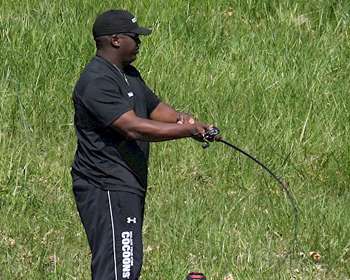
Every angler who has spent 10 minutes on the water during sunny conditions understands the importance of quality eyewear, yet few give lens color much thought. Typically, lens selection comes down to whichever color is in the frame of choice.
To Elite Series pro Ish Monroe, lens selection is an extremely important component to success on the water. "I've been wearing Cocoons Eyewear for about seven years now, and they make a lens for each and every situation," he explains. "My primary choice is an amber lens, which is a fairly dark lens that brings out the contrasting colors under the water's surface extremely well."
According to Monroe, contrast is of particular relevance when sight fishing. "I won't wear another color lens if I'm bed fishing," he reveals. "An amber lens reveals the greens and blacks under water to the point that when the fish is sitting on a bed, it stands out so much better."
In addition to an amber lens, Ish points out that a copper-colored lens, which bears many of the same qualities as amber, is quickly becoming a standard for him when competing. "A copper lens is a little bit darker, which really helps on bright days," he says. "It makes a difference in eye fatigue over the course of a day if you have a lens that's a little darker.
That minor shade of difference between amber and copper can make for a much more enjoyable day if the sun is out," says the California pro. He classifies the amber lens as great for bed-fishing scenarios, while the copper lens has proven itself on brighter days. But for those days when the sun is ultrabright or sight fishing isn't on the menu, he opts for a grays lens instead. "
The gray lens is phenomenal because it shadows everything (enhances contrast) a whole lot better when everything is so bright," he points out. "On a typical sunny day, I may not put the gray lenses on until after noon, when the sun is at its highest point, because they do shade things so much."
By contrast, Ish explains that there are lenses he uses for low light conditions — particularly during early morning runs — that are yellow. "The yellow lens captures light and brightens things up during low-light conditions," he explains. "I carry multiple glasses and lenses with me when I'm out on the water. I've just found that by having glasses with different lens shades, I'm able to have eye protection during any light level and fishing application I might be faced with during the day."
Ish comments that many anglers overlook the importance of lens color and the added value it brings. "Just in normal light conditions, I see a lot of guys out there with darker lenses," he says. "I also see a lot of anglers wearing yellow lenses during bright conditions.
Basically, in both scenarios they're just keeping themselves from seeing a lot of what's going on under the water's surface," he opines. Ish explains that amber and copper lenses are the most widely used lens colors on the market today, and that when used in the right conditions, will be beneficial in most any situation.
"It's really hard to choose between those two lenses in terms of which one is the best," he says. "The biggest key is that whichever lens you use, it has to be 100 percent polarized to reduce the glare on the water and it has to have 100 percent UV protection."
(Provided by Z3 Media)




